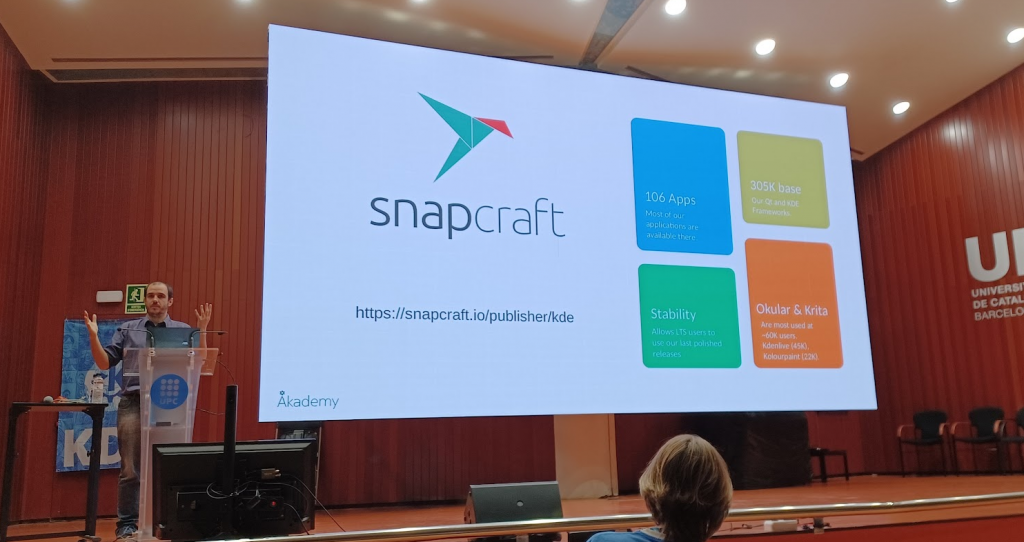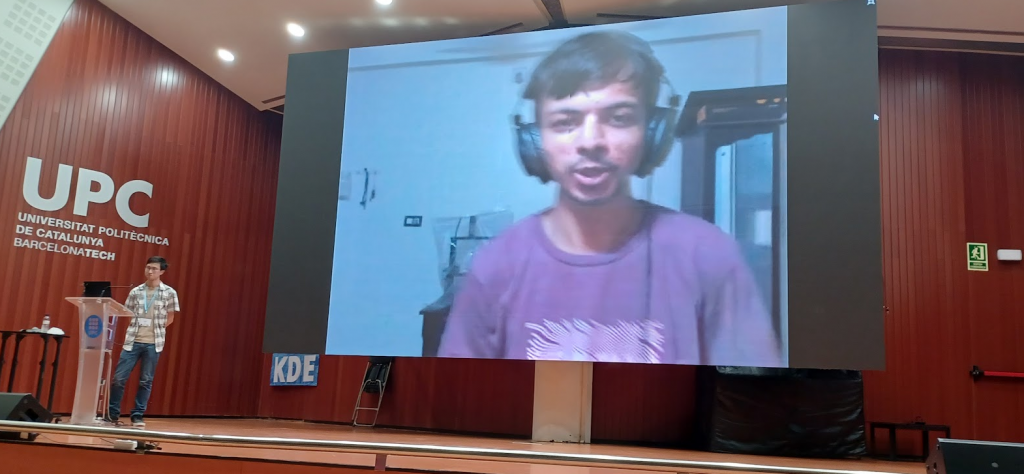
Akademy is back, online and in person. FFP2 masks being the only sign of a pandemic having happened. Barcelona is warm and sunny and we’re meeting at the Universidad Polytechniqua de Catalunya in grand lecture theatres with high def projectors. It’s great to see some old faces and some new and discuss the progress of the last couple of years since we could last meet. Here’s some notes on some talks I went to.
Volker Hilsheimer gives the keynote aschief architect of Qt for last 6 months. We are 2 years into Qt 6 and stuff is still being ported. Qt 6.4 is now out and it adds QtLocation as the last major module to be ported to 6. Qt WebAssembly is an important development, zero deploy, near native performance, Web in Qt and Qt in Web, they consider it to be Docker for Apps. How will KDE use it? Lots of work is happening to make Qt prepared for C++20. C++23 is on its way, stuff like the stack tracing library will be valuable. There’s some C++ successor languages upcoming like cppfront and carbon which they want to see what’s relevant. Python is something they have invested in. People are asking about Rust, they’re not actively doing anything but it’s something they’ll need to look into. Many people think of Qt as a user interface library, that’s not the only aspect but it’s a big part of it. What controls are still missing? QtWidgets they won’t throw much resources at, they will keep it relevant and up to date but QtQuick is where they want to put effort. They have not spent a great deal of time making sure Qt apps look great on the Linux desktop in recent years – they are now looking at that again. HMI, Human Machine Interface, is relevant. Connectivity is interesting for Qt (it’s not just a UI framework). Community is important for the Qt project, there’s a long and good history with the KDE community. Qt now has a community manager Pedro Bessa (who takes the stage). Almost 100% of the real world problems being solved with Qt is done outwith Qt Company so your perspective is important to them. 1/3 of maintainers are outside the Qt Company. Having an ecosystem for Qt. A question about speed recognition in Qt? Yes, contribution was this summer to QtSpeech repo.

Adam Szopa goals talk. Goals initiative was started in the distant past of 2017. In 2019 Wayland, Consistency and All About the Apps kicked off. Then Covid happened.
Aleix talks about Apps: if humanity used more of our apps we would have less wars. It’s hard for us to do all the work. Are we as good as it gets to getting the last mile? On all the stores and all the platforms? We always have a one to one relationship with the app and the user. Snapcraft has most apps and 350k base users, 60,000 installs of Krita and Kdenlive. Flathub has 120 apps with Krita and Kdenlive most popular at about 25,000 installs. On Google Play Krita has 1m active installs (Android and ChromeOS) which KDE Connect has 300k installs. The Craft SDK now works for Android. KDE Connect uses native Java-style code in Android. Windows store has lots of users, 1M Krita installs but otherwise only 8 apps. Apple not convenient, incompatible with GPL in the store.

Niccolo and The Dawn of Consistency. He gives the example of KHamburgerMenu which should have a similar widget which is a panel, having a common component was something he kept talking of but it was never done. App redundancy, one part of the goal was removing multiple applications. This depends if KDE is an umbrella for any app or if it’s a brand that promotes a set of apps. For example Maui is very much doing the wrong thing with their own design with their own Kit and they have their own shell but MauiShel isn’t part of KDE even though MauiKit is. Maybe we should have a requirement for KDE look and feel as part of being KDE. Some apps are a bit stagnant, in general I’d like to move them to Kirigami because that helps consistency. Kate and KWrite use the same code so congratulations. Band consistency, many apps had their own website, there has been a lot of improvement for this. Consistency within applications has improved.
Méven talks about Wayland goal. In Plasma 5.24 we got the Overview Effect, improved NVidia support (where the distro uses the patches), improved stability too. In Plasma 5.25 we got touch mode for better tablet support and a tonne of stability improvements. In Plasma 5.26 we got improved virtual keyboard support, improved graphical tablet support, xwayland and DPI improvements and a lot of stability improvement. But showstoppers are still missing colour profiles, blurry rendering with fractional scaling and many more. Virtualisation and screen recording still needed before people can switch from X.
Announcing the New Goals for 2022:
KDE For All: Boosting Accessibility with Carl
Automate and systematize internal processes with Nate – make sure people’s processes they know about are automated so when they move on that knowledge is still there, e.g. bug triaging, CI checks, document knowledge, doing off-boarding when people leave,
Sustainable Software with Corelius, see eco.kde.org

Tomaz spoke on Terminals. Unix users will use a shell, but terminals are difficult. He got some users to use different terminals with various tasks: how to change text size, how to open another program etc. 5 different universities took part. Changing text size. For xterm etc 0%, gnome-terminal 90% could but the name of option is “zoom”. Konsole 100%. Kitty is a new terminal based on Rust got 70%. Copy and paste didn’t work well as everyone used control-c (except on MacOS) maybe we should allow control-C for copy. One student cried in despair. Thankfully Konsole has sane defaults but we are still far from good. He demos the SSH session panel and the quick commands
Devin Lin and Bhushan spoke about Plasma Mobile. Within Plasma Mobile there’s over 40+ projects, 300+ tickets and 6+ active downstreams (opensuse, fedora, manjaro, postmarketOS etc). He showed the new shell as it will be in Plasma 5.26. He shows the quick settings. In the middle is the pin view with notifications, the same tech as desktop. He shows the audio applet and lock screen notifications. For telephony they switched from ofono to modemmanager. Plasma Dialer is for calls. Spacebar app is for SMS and MMS. callaudiod from Mobian for audio routing. There’s convergent apps like Discover, Elisa, Koko, Kasts, Neochat, KClock etc. Some mobile specific apps like Angelfish, QMLKonsole. Supports Pinephones and postmarketOS supporter devices such as OnePlus 6. It can also be installed anywhere on Linux distros. But there is more vendor lock in coming, a fragmentation between open mobile communities. Coming up: Kontact. Improved tablet support. And a great feature would be full convergence – you can walk up to monitors and plug in mouse and keyboard and get a desktop.

